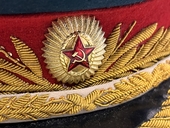
Russian Empire. Sign for lower ranks "For excellent Rifle Shooting."
1, Early (light bronze, screw. Berdana) - 100 euros
2, Early (light bronze, screw. Berdana) - 70evro (soldered pin)
3, Late (white metal, Mosin screw) - 90 (sold) converted to pendant
Emperor Alexander II of May 10 (May 22), 1879, announced in an order for the military department - "On the establishment of a special metal sign for wearing on the right side of the chest to encourage excellent shooters of all infantry and cavalry units and for their external distinction." Until 1909 he had one degree. It was made of bronze and was a round disk with relief circles in the form of a target, with an inscription around the circumference "For excellent shooting" and two crossed rifles (Berdan) later than Mosin, superimposed on the target. By the highest decree of Nicholas II of August 6 (August 19), 1909, three degrees of this sign were introduced.
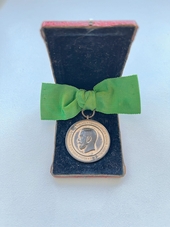
The Russian Empire is the Grand Duchy of Finland. Bronze medal for work in agriculture of the Finnish principality. With a bow (for women) in a case.
Very rare kit.
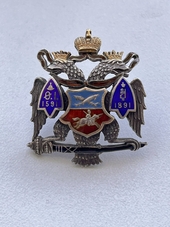
Russian Empire. Sign of the Ural Cossack army. Officer. The badge was approved on February 18, 1912 in memory of the 300th anniversary of the army in 1891. On the reverse is the name of the unknown master "BP" and the assay mark "84, female head in kokoshnik, Greek delta." Extremely rare.
The badge is a silver oxidized double-headed eagle, similar to the eagle depicted on the seal of John the Terrible holding in his paws an ataman saber with a black enamel shaft. The crowns of the eagle are connected by an enamel St. George ribbon running along the chest of the eagle.
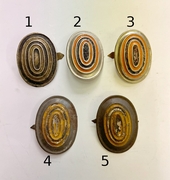
Russian Empire. Late 19th and early 20th century. Cockades of the lower ranks of the Russian army for caps and hats.
Nos. 2,3 - 50 EUR
№№ 1,4,5. - €35
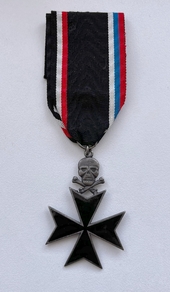
Russian Empire - Northwest of Russia (civil war). 1919. Avlova-Bermont Western Volunteer Army Cross II Civil Merit.
Maltese cross of white metal, covered with black matte varnish or black enamel, size 51 mm. The cross was called an order and had two degrees. The military was awarded a cross with swords, and civilian - without swords. The cross of the 1st degree was worn around the neck on a black ribbon with a border: on the one hand, Russian national colors (white-blue-red), and on the other, German (black-white-red). When worn around the neck - Germanic colors at the top, the same when wearing the second degree on the chest with a bow.
A smaller 2nd degree cross.

Russian Empire. Early 20th century. Porcelain cockade of gendarme officer ranks and railway officials for hats with various types of uniforms. Very rare due to the fragility of the material.
1. Railway - 190 euros
2. Railway - 190 euros
3. Gendarme - 250 euros

USSR. The buttonhole badges of the NKVD and the Red Army in 1930-40.
- Tanker size 22*9mm - 100 euros.
- A star on hats - 50 euros (one "mustache") - 50 euros
- Lieutenant's cube - 60 euros
- NKVD internal guards 1935-37 - 180 euros.
- The shooter - 130 euros, a shortened screw without a nut - 50 euros.
- Sergeant's triangles - 60 euros
- Breast patch for severe injury - 100
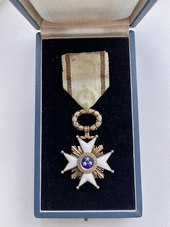
Republic of Latvia. The highest state award of the Republic of Latvia, the first civil order of the country. It was first established on March 24, 1924 in memory of the creation of the Latvian state. The order was divided into five degrees.
Fifth degree.
From 1924 to 1940, the order was awarded 8810 times.
Order of the 1st degree - 285 times
Order of the II degree - 391 times
Order of the III degree - 1323 times
Order of the IV degree - 2194 times
Order of the V degree - 4617 times
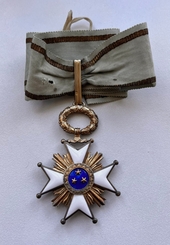
Republic of Latvia. The highest state award of the Republic of Latvia, the first civil order of the country. It was first established on March 24, 1924 in memory of the creation of the Latvian state. The order was divided into five degrees.
The second or third degree.
From 1924 to 1940, the order was awarded 8810 times.
Order of the 1st degree - 285 times
Order of the II degree - 391 times
Order of the III degree - 1323 times
Order of the IV degree - 2194 times
Order of the V degree - 4617 times
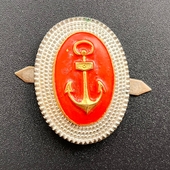
Russian Empire. Late 19th and early 20th century. Cockade boatswain of the RI voluntary fleet.
Voluntary Fleet - a government-controlled Russian and Soviet maritime shipping society, founded on voluntary donations in 1878, in 1925 included in Sovtorgflot
Very rear.
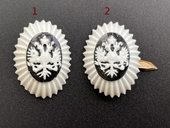
Russian Empire. Kokard, official of the state railways of the Russian Empire, porcelain. Firm "Privilege."
The price of one cockade is indicated.
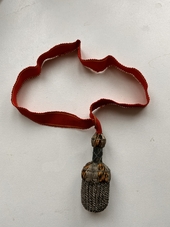
The Russian Empire. A sword-knot bumped for a premium weapon. Order of St. Anne 4th degree "For Courage." Moire ribbon. "Bump" infantry type from silver twisted thread.
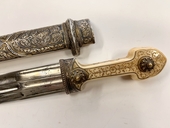
Russian Empire. Dagger Chechen in silver. The blade is multi-sided, straight, not chiseled. Bone handle with gold wire ornament. Rich scabbard, gilded, blackened, decorated with floral ornaments in the traditional style.
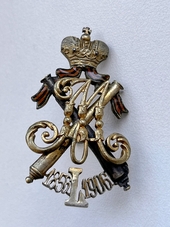
The Russian Empire. Badge "In memory of the 50th anniversary of His Imperial Highness Grand Duke Mikhail Nikolaevich in the post of Field Marshal". It was established in January 1906.
The right to wear the badge was initially granted to all artillery officers and class ranks of the artillery department who were on the artillery lists on the anniversary day. A little later, by order No. 457 of the military Department dated July 28, 1906, officers who were cadets in additional classes at the Mikhailovsky and Konstantinovsky artillery schools on the anniversary day were included in this list.
After the death of Grand Duke Mikhail Nikolaevich, Emperor Nicholas II, by his decree of January 24, 1910, extended the right to wear the badge to all artillery officers and class ranks of the artillery department who served at any time from January 25, 1856 (date of appointment of Mikhail Nikolaevich to the post of Field Marshal) to December 5, 1909 (date death of the Grand Duke)[
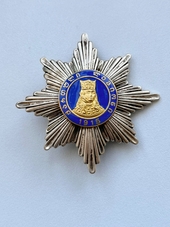
Georgia. Award of the queen Tamara. The military personnel of the German army who was during World War I and Civil wars on the Caucasian battlefield was awarded.
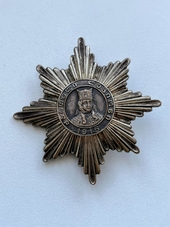
Georgia. Award of the queen Tamara. The military personnel of the German army who was during World War I and Civil wars on the Caucasian battlefield was awarded.
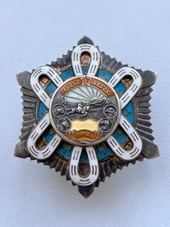
Order of the Polar Star (Mongolia)
The highest award of the Mongolian Republic. The Order was established in 1936. Since 1936, the order's appearance has changed several times.(4 types).
According to Herfurt, about 300 awards were made by type I of the order (according to other sources - over 600), type II - about 2000, type III - about 12,000, type IV - over 16,000.
The Order of the Polar Star of the MNR is awarded to soldiers, officers, political workers of the MNR, soldiers of the border troops of the Ministry of Internal Affairs, soldiers, workers, employees and other citizens who have achieved remarkable success in strengthening the military power of the MNR, strengthening the country's defense capability, developing the national economy, culture and healthcare.
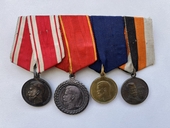
The Russian Empire. Award-winning shoe of the police rank, during the reign of Emperor Nicholas II. Consisting of medals: "For diligence", "For immaculate service in the police", "For his efforts in the excellent implementation of the general mobilization of 1914" and "In memory of the 300th anniversary of the House of Romanov"
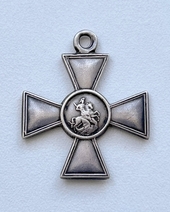
The Russian Empire. St. George's Cross of the 4th degree No. 599307.
Awarded to Nikolai Matveyevich Andreev, 22nd Mortar Artillery Battalion, gunner. For the fact that on 05/31/1916, near the village of Gayvoronka, under heavy enemy fire, with obvious danger to life, he extinguished a fire that had started at the location of the cellars with shells.
